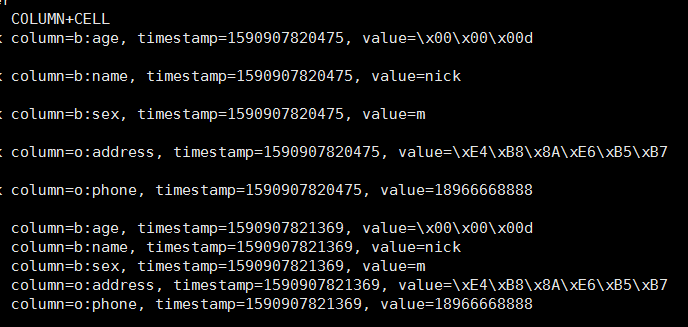Spring Boot版本v1.5.19.RELEASE
1、增加Jar
<dependency>
<groupId>com.spring4all</groupId>
<artifactId>spring-boot-starter-hbase</artifactId>
<version>1.0.0.RELEASE</version>
</dependency>
2、创建表
创建命名空间pb
create_namespace 'pb'
在pb命名空间下创建用户表
create 'pb:user', {NAME => 'b', VERSIONS => '3', TTL => '2147483647', 'BLOOMFILTER' => 'ROW'}, {NAME => 'o', VERSIONS => '3', TTL => '2147483647', 'BLOOMFILTER' => 'ROW'}user表下有b和o列族
3、配置参数。
主要是hbase的配置。程序的部署环境和hbase的部署环境是同一台linux服务器。
spring:
application:
name: hbaseDemo
kafka:
bootstrap-servers: localhost:9092
consumer:
group-id: mygroup
listener:
concurrency: 4
data:
hbase:
quorum: localhost:2181
rootDir: hdfs://localhost:9000/hbase
nodeParent: /hbase
redis:
host: 127.0.0.1
port: 6379
server:
port: 8080
logging:
file:hbaseDemo.log
level: debug
4、实现访问HBase数据库的关键代码
1) 基本信息
用户信息User。包括用户基本信息BaseInfo 和其它信息OtherInfo
@Data
@NoArgsConstructor
@AllArgsConstructor
public class User {
/** 用户 id */
private Long id;
/** 用户基本信息 */
private BaseInfo baseInfo;
/** 用户额外信息 */
private OtherInfo otherInfo;
@Data
@NoArgsConstructor
@AllArgsConstructor
public static class BaseInfo {
private String name;
private Integer age;
private String sex;
}
@Data
@NoArgsConstructor
@AllArgsConstructor
public static class OtherInfo {
private String phone;
private String address;
}
} 用户表结构常量。代表Hbase的表结构,表名为pb:user,列族分别为列族基本信息b和列族其它信息o。
列族基本信息b包括列字段name,列字段age,列字段age
列族其它信息o包括列字段phone和列字段address
public class UserTable {
/** User HBase 表名 */
public static final String TABLE_NAME = "pb:user";
/** 基本信息列族 */
public static final String FAMILY_B = "b";
/** 用户名 */
public static final String NAME = "name";
/** 用户年龄 */
public static final String AGE = "age";
/** 用户性别 */
public static final String SEX = "sex";
/** 额外信息列族 */
public static final String FAMILY_O = "o";
/** 电话号码 */
public static final String PHONE = "phone";
/** 住址 */
public static final String ADDRESS = "address";
}
2)Controller层代码
直接调用服务层的创建用户
@ResponseBody
@PostMapping("/createuser")
Response createUser(@RequestBody User user) throws Exception {
return userService.createUser(user);
}
3)服务层代码
Hbase客户端
/** HBase 客户端 */
private final HbaseTemplate hbaseTemplate;
/** redis 客户端 */
private final StringRedisTemplate redisTemplate;
@Autowired
public UserServiceImpl(HbaseTemplate hbaseTemplate, StringRedisTemplate redisTemplate) {
this.hbaseTemplate = hbaseTemplate;
this.redisTemplate = redisTemplate;
}保存用户信息
@Override
public Response createUser(User user) throws Exception {
byte[] FAMILY_B = Constants.UserTable.FAMILY_B.getBytes();
byte[] NAME = Constants.UserTable.NAME.getBytes();
byte[] AGE = Constants.UserTable.AGE.getBytes();
byte[] SEX = Constants.UserTable.SEX.getBytes();
byte[] FAMILY_O = Constants.UserTable.FAMILY_O.getBytes();
byte[] PHONE = Constants.UserTable.PHONE.getBytes();
byte[] ADDRESS = Constants.UserTable.ADDRESS.getBytes();
//Long curCount = redisTemplate.opsForValue().increment(Constants.USE_COUNT_REDIS_KEY, 1);
Long userId = genUserId(++curCount);
List<Mutation> datas = new ArrayList<Mutation>();
Put put = new Put(Bytes.toBytes(userId));
put.addColumn(FAMILY_B, NAME, Bytes.toBytes(user.getBaseInfo().getName()));
put.addColumn(FAMILY_B, AGE, Bytes.toBytes(user.getBaseInfo().getAge()));
put.addColumn(FAMILY_B, SEX, Bytes.toBytes(user.getBaseInfo().getSex()));
put.addColumn(FAMILY_O, PHONE, Bytes.toBytes(user.getOtherInfo().getPhone()));
put.addColumn(FAMILY_O, ADDRESS, Bytes.toBytes(user.getOtherInfo().getAddress()));
datas.add(put);
hbaseTemplate.saveOrUpdates(Constants.UserTable.TABLE_NAME, datas);
user.setId(userId);
return new Response(user);
}
4) 使用接口调用
JSON格式
{
"baseInfo": {
"name": "nick",
"age": 100,
"sex": "m"
},
"otherInfo": {
"phone": "18966668888",
"address": "shanghai"
} }
5) 查看HBase 表中创建的用户
scan pb:user

来源:oschina
链接:https://my.oschina.net/u/4309418/blog/4297748